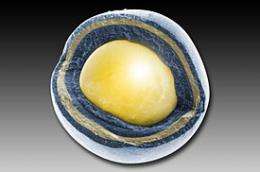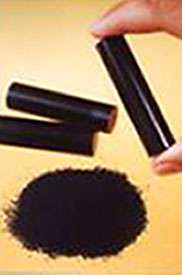INL develops safer, more efficient nuclear fuel for next-gen reactors

As the nation ponders its energy choices, Americans keep asking themselves: how can the country make better use of its resources and emit fewer greenhouse gases without hurting U.S. industries? A research project at Idaho National Laboratory may have part of the answer.
INL researchers have developed a new type of nuclear fuel that leaves less waste and could help industries burn fewer carbon-emitting fossil fuels. The fuel is designed for the Next Generation Nuclear Plant (NGNP), which could provide the heat and hydrogen many industries currently get from fossil fuels.
The advanced nuclear fuel, which would be used in next-generation high-temperature gas reactors, has set a particle fuel record by consuming approximately 19 percent of its low-enriched uranium. That's more than double the previous record set by German scientists in the 1980s, and more than three times that achieved by current commercial light water reactor fuel. Such high "burnup" levels can reduce the amount of unused fuel coming out of next-generation reactors.
Additionally, none of the new fuel particles have experienced material failures since entering the extreme neutron irradiation test environment of the Advanced Test Reactor in December 2006.
"This level of performance is a major accomplishment," said Dr. David Petti, director of the Very High Temperature Reactor Technology Development Office at the U.S. Department of Energy's INL.
The Advanced Gas Reactor (AGR) Fuel Program was initiated by the Department of Energy in 2002 to develop this particle fuel, produce experimental data to demonstrate its safety and robustness, and re-establish a U.S. fuel manufacturing capability for high-temperature gas reactors. The overarching goal of the AGR Fuel Program is to qualify coated nuclear fuel particles for high-temperature gas reactors such as the NGNP.
"An important part of our mission is the development and exploration of advanced nuclear science and technology," said Dr. Warren F. "Pete" Miller, assistant secretary for Nuclear Energy. "This achievement is an important step as we work to enable the next generation of reactors, decrease fossil fuel use in industrial applications, make fuel cycles more sustainable and reduce proliferation risks."
"AGR-1" is the first of eight similar experiments that aim to confirm designs, fabrication processes and performance characteristics for advanced reactor fuel. It used INL’s unique Advanced Test Reactor (ATR) in a nearly three-year experiment to subject more than 300,000 nuclear fuel particles to an intense neutron field and temperatures around 1,250 degrees Celsius. The team is monitoring the AGR fuel for a number of factors including "burnup," a measurement of the percent of uranium fuel that has undergone fission reactions.

The 18-foot-long AGR-1 experiment was inserted in INL's ATR core, which lets researchers separately monitor and control each of six capsules containing the particle fuel specimens. Inside the ATR core, the fuel samples were subjected to neutron irradiation many times higher than what they would experience inside a high-temperature gas reactor or a current light water reactor. These conditions reduced the amount of time researchers needed to get data about how irradiation affected the performance of fuel and materials.
Although the experiment has now left the ATR, researchers still have more work to do. Post irradiation examination (PIE) at INL and Oak Ridge National Laboratory facilities will allow scientists to examine the samples up close. They will evaluate the fuel and its layers of coatings for degradation patterns and other characteristics. In addition, controlled higher temperature testing in furnaces is planned to determine the safety performance of the fuel under postulated accident conditions. These activities will last another two years.
The NGNP Program aims to use a high-temperature gas reactor to produce the high-temperature process heat and hydrogen many industrial facilities use in daily operations. This work also will support the broader goal of developing the next generation of nuclear power systems that can provide abundant carbon-free electricity on a 24/7 basis.
INL has been working with Babcock and Wilcox Inc., General Atomics and ORNL to establish standards and procedures for the manufacture of commercial-scale HTGR fuel. Excellent fuel irradiation performance must be demonstrated before high-temperature gas reactors can be licensed and co-located with complementary industrial facilities. Reaching this world record peak burnup of 19 percent without any material failure demonstrates the robustness of this particle fuel design.
Provided by Idaho National Laboratory (news : web)

















